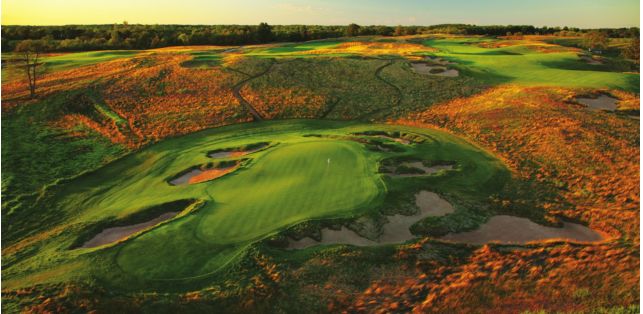
Even Illinois golf courses aren’t up to par
If Mr. Rauner thinks that reforming workers’ comp is hard, wait until he tries to reform geology. It turns out that yet another reason Illinois Inc. is not economically competitive with neighbor states is that its landscape is too plain. We know that because golf course developer Mike Keiser said so to Crain’s the other day. He said that he has never built a course in Illinois and probably never will because “cornfields are not good places to be building courses. Wisconsin has more interesting land.”
Comely views have always been vital to keeping our plutocrats in an even temper, which is why early venues for their favorite game were inevitably built on stream-carved topography with its pleasing interplay of ravines and water and rolling, wooded terrain. Courses at Springfield’s Illini Country Club and at Pasfield and Bergen parks are examples of what is known as the parkland style of course design. More exalted versions of such courses include the Chicago area’s Medinah, Cog Hill and Olympia Fields, which for decades were regular venues for major tournaments, and the only reason for the world to come to places in Illinois outside the Loop.
All this matters terribly, of course, because pleasuring the well-to-do is, apparently, the state of Illinois’ only economic development strategy. While the rugged individualists among our enterprising classes – the modernday business equivalents of the prospectors, the cattle drivers, the bounty hunters like Rauner – prefer fishin’ and ridin’ and go where they can find it (usually in the mountains or the West), the corporate bureaucrat is much more likely to be found on the links, emulating our nation’s Golfer in Chief, playing with people who will never dare beat him. That’s why the people who run big companies locate their businesses and buy big houses near their favorite golf clubs, thus improving the local tax base, if not the cultural tone.
The effects of Illinois’ not being uncompetitive, geologically speaking, affects more than the market for big ugly houses.
Wisconsin will host the next Ryder Cup at Whistling Straits, which has already been the site of PGA Championships in 2004, 2010 and 2015. The U.S. Open tournament hasn’t been played in Illinois since 2003, but the Open will be contested this year (beginning June 15) in Wisconsin. These are big-money events; the crowds at the Open are predicted to spend “more than $130 million” and invigorate the area’s cargo shorts boutiques.
Alas for Illinois, the parkland style is out of style. The vogue at the moment is for courses in the links style, inspired by the rugged, mostly treeless courses on dunes land where golf began on the coasts of England, Ireland and Scotland. A spectacular Wisconsin example of this linksstyle course is Whistling Straits near Sheboygan.
I am far from the only fan of TV golf who is interested less in watching golfer vs. golfer than golfer vs. course and there’s a wildness about the new courses that makes for compelling watching.
Courses like Whispering Straits look natural compared to a manicured, blow-dried layout like Olympia Fields, but there’s nothing natural about most of our faux links courses. Before Whispering Straits was built, the property was an abandoned airfield; the architect hauled in more than a half a cubic mile of soil to reshape it. Whispering Straits is as much a links course as a water park slide is a mountain stream.
A happy exception, I am told, is this year’s Open site, Erin Hills Golf Club, out in the Wisconsin countryside 40 miles northwest of Milwaukee. Erin Hills is a heathland-style course, a sort of inland links course; this one exploits the site’s natural kettle-moraine topography shaped by glacial ice and winds rather than by waves, and has been developed using minimal water and chemicals.
The glaciers might not have left much interesting land in Illinois, but Illinoisans have been busy trying to make up for it by rearranging the landscape ourselves. Enterprising golf developers/owners have long exploited landfills, worked-out quarries, abandoned strip mines and derelict factory grounds. Two of Illinois’ links-style layouts are at Chicago’s Harborside International Golf Center, which opened in 1994 on 450 acres of old steel mill property along Lake Calumet on the sout’ side.
It is not only the windswept terrain that makes links courses distinctive but the fitful weathers that sweep across them off the water. (As the Scots say about links golf, “Nae wind, nae rain, it’s nae golf.”) The inland sea that borders Illinois and Wisconsin does nearly as well, but a course doesn’t need to sit on the shore to offer shore-like winds. Out in the western suburbs, Chicago Highlands was built in the heathland style atop a landfill, a literal mountain of garbage that sits several stories above Westchester just off I-294. There’s nothing to block the wind up there, and a breeze that a few minutes earlier might have caressed the face of a shopper coming out of Camille La Vie at Woodfield can push your lofted nine-iron into the trap. Who needs scenery?
Contact James Krohe Jr. at [email protected].
Editor’s note
I’m
pleased to announce that Michelle Ownbey was recently promoted to
publisher of Illinois Times and Springfi eld Business Journal. She was
associate publisher of Springfi eld Business Journal since January 2014,
when it was acquired by Illinois Times. Earlier in her career, Michelle
had been advertising manager of the Springfi eld Business Journal from
2001 to 2006, followed by seven years as a commercial real estate broker
for Coldwell Banker. A graduate of Illinois College, Michelle is active
in Springfi eld community affairs, serving in several unpaid positions –
commissioner on the City of Springfi eld Economic Development
Commission, president of the Enos Park Neighborhood Improvement
Association and commissioner on the Mid-Illinois Medical District board.
As part of our reorganization, we’ll soon be adding two new staff
positions, so stay tuned. –Fletcher Farrar, editor and CEO